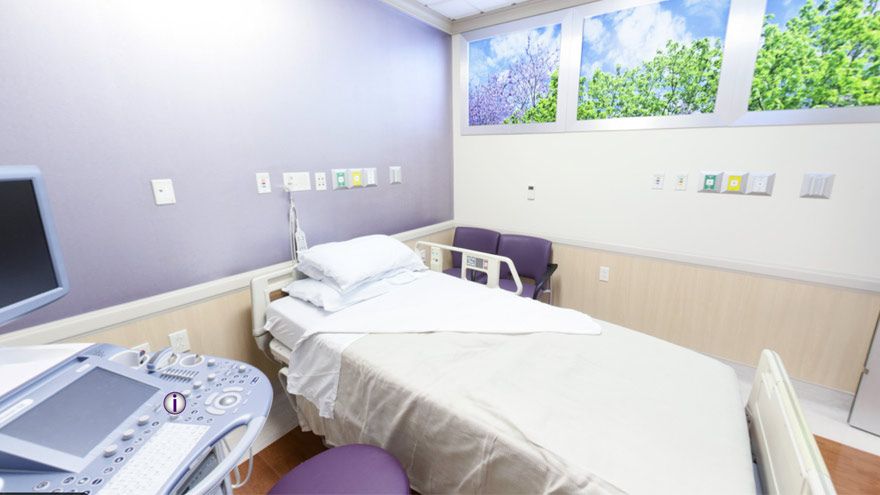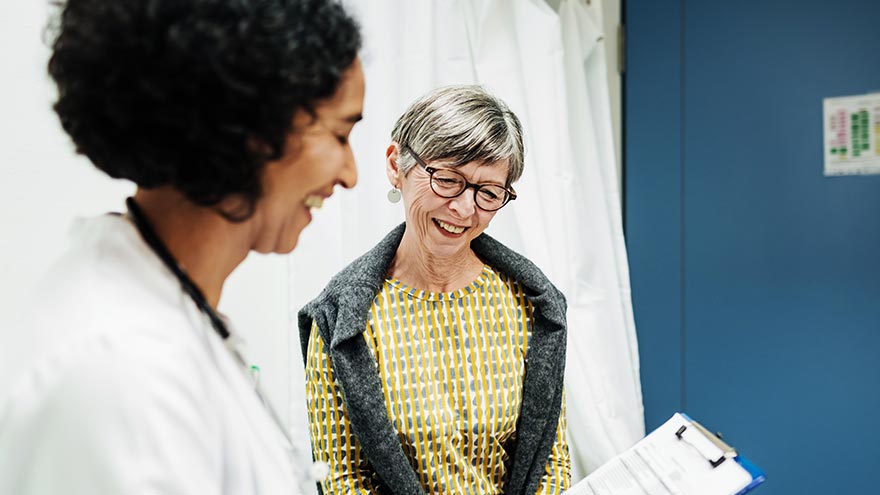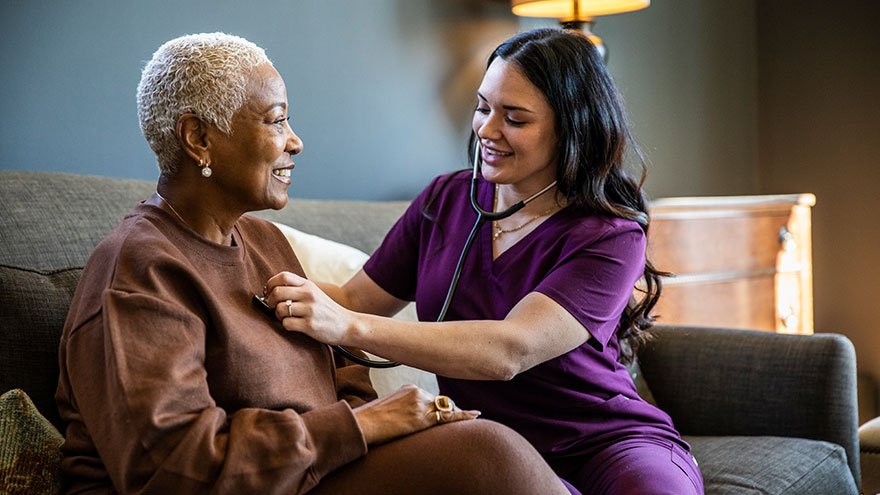Search
-
Alzheimer's Safety Tips for Caregivers to Know
November is National Alzheimer’s Disease Awareness Month. At Renown Health, we know that Alzheimer's safety for your loved one is a priority, as the symptoms can sometimes lead to unsafe situations. We asked Dr. Jonathan Artz – a neurology physician with Renown Health and an assistant professor of clinical neurology at the University of Nevada, Reno School of Medicine – for tips on keeping loved ones safe and secure. According to the Alzheimer’s Association, Alzheimer’s disease affects safety in various ways, specifically due to body and brain adjustments. These changes can include: Judgment, including forgetfulness Sense of place – getting lost on the way home Behavior – being suspicious or fearful Body difficulty – losing balance Sensing ability – noticeable sensitivity in hearing, seeing or temperature Dr. Artz gives us four major tips to ensure your loved one’s safety as you both navigate this disease together. Watch for Wandering Those experiencing Alzheimer’s disease tend to wander and get lost. Try the following tips to reduce the risk of wandering: Get your loved one an ID bracelet and have them wear it at all times. You can also enroll your loved one in “Wandering Support.” Install door chimes so you know when exterior doors are open. Ask neighbors to call you if they see your loved one out alone. Go with your loved one when they insist on leaving the house. Don’t argue or yell. Instead, use distraction or gentle hints to get them to return home. Discourage Driving Driving can be unsafe for someone with this disease. With this in mind, ask a doctor whether it’s safe for your loved one to drive. For example, on a case-by-case basis, there are certain situations where doctors are required to report individuals with particular cognitive impairments, wherein a form of a driving assessment will be recommended. Limit access to the car. Keep the keys with you or lock them away. Ask an authority figure, such as an insurance agent or a doctor, to tell them not to drive. Adult-Proof Your Abode A simple living space is a safe living space. This means reducing clutter and removing any issues that may pose a safety concern. You may also want to get advice from an occupational therapist (home safety expert). Keep in mind that some changes may not be needed right away. Focus on major safety concerns first. Try the following tips: Add lighting (or glow-in-the-dark tape) to brighten dark areas, including stairways and halls. Use color contrast or texture indicators for dials, knobs and appliance controls. Remind your loved one not to carry items while walking to avoid a fall. Remove sharp objects from drawers and countertops. Avoid using small throw rugs or doormats, as they are easy to trip on. Move frequently used items so that they are easy to reach. Lock away alcohol and tobacco products, as they are not recommended for dementia patients. Install handrails in the shower, tub and near the toilet. Bathroom falls are especially common. Adjust the setting on your hot water heater so water does not scald. Those with Alzheimer’s can lose their sensitivity to temperature. Move and lock up hazardous chemicals and cleaning supplies, such as bleach and insecticides. Disable and remove guns or any weapons. Supervise any medication taken by your loved one. Promote a Positive & Healthy Lifestyle Continually emphasize the strengths of your loved one by promoting participation in meaningful activities, wellness visits and healthy habits to help them improve their well-being. Here are some ways to keep them physically and mentally active: Maintain regular vision and hearing screenings and make necessary adaptations. Establish a routine for daily activities. Encourage participation in self-care and leisure activities. Work with your loved one’s doctor to establish a healthy diet. Ensure proper hydration. It may help to set reminders for your loved one to drink fluids. Encourage regular exercise. Exercise delivers oxygen to the brain, improving brain health. Promote good sleep habits. Good quality sleep can increase overall brain health and has been associated with improving memory, attention and concentration. Resources and support are available with the Renown Memory Disorders Program. Providers within this program are specifically dedicated to treating several different memory-related disorders. Memory Disorders Resources & Support.
Read More About Alzheimer's Safety Tips for Caregivers to Know
-
10 Facts About Seasonal Affective Disorder
Seasonal Affective Disorder (SAD) is a form of depression linked to seasonal changes. Learn to recognize the symptoms of SAD in your kids (or yourself) should they appear. We checked in with Dr. Vanessa Slots, the Division Chief of General Pediatrics at Renown to help us understand this condition. 1. Blame SAD on the sun—or the lack of it Seasonal Affective Disorder is a more severe form of the “winter blues. Over-sleeping, feeling irritable or unhappy, and withdrawing from people are classic symptoms of SAD. Approximately 90 percent of people with SAD experience depressive symptoms yearly in the fall and winter, while about 10 percent have depression in the spring and summer. The causes of SAD aren’t explicitly known. Still, researchers believe it’s related to a change in circadian rhythms, with differences in the amount of sunlight during different times of the year as one factor. 2. The further north you live, the more common SAD becomes While Seasonal Affective Disorder is predominantly an adult condition, estimates are that one million children in North America have it. Interestingly, SAD does not occur in the tropics. 3. SAD is more recognizable in adults than in children Common symptoms include feeling “empty,” pessimistic, hopeless, short-tempered, restless and not knowing what to do with oneself. Symptoms vary greatly from one individual to the next. SAD is more common in women than in men. When symptoms are severe, physical examinations are required to rule out other medical causes and determine whether antidepressant medication is needed. 4. In teenagers, symptoms tend to revolve around school-related issues Schoolwork suffers, students have difficulty getting up in the morning and arriving late for class, homework is incomplete, and grades may plummet. Afflicted students have difficulty concentrating, remembering details and making decisions. They lose interest in activities that they previously enjoyed. Some teenagers tend to overeat, crave carbohydrates such as pasta and gain weight. Many teachers, school counselors and therapists should be more familiar with Seasonal Affective Disorder.
-
Remove the Guesswork with Renown’s Labor Assessment Area
Pictured above: A section of Renown’s Labor Assessment Area. When patients expecting a new child are about to give birth, nerves can be especially heightened. Questions flood their minds: Is the baby actually on the way? What’s going to happen next? Are we ready to push? Lucky for them, at Renown Health, the guesswork can finally end with Renown’s Labor & Delivery unit Labor Assessment Area. This unique space is a triage area that helps make more precise labor diagnoses by determining exactly what stage expectant parents are at in the labor process. Funded by a state grant more than a decade ago, the six-bed Labor Assessment Area sees 500-600 patients per month – from patients entering the unit directly, unsure if they are in active labor, to patients who are sent over from elsewhere experiencing labor symptoms, such as high blood pressure and water breaking. The area also serves as a pre-operation space for patients getting ready for procedures such as C-sections. The six cubicles that are enclosed with doors and curtains ensure each patient gets the private, one-on-one care they need. Furthermore, rather than sitting in a waiting room, this area allows expectant parents a comfortable place to prepare for labor. “We are a unit that prides ourselves on getting patients into beds very quickly,” said Debbie Hawley, Associate Nurse Manager in Renown’s Labor & Delivery unit. “This area has allowed us to triage more effectively and allow more patients to collaborate with their provider in a quick manner.”
Read More About Remove the Guesswork with Renown’s Labor Assessment Area
-
Top Safe Sleep Tips for Your Baby
Becoming a parent for the first time means lots of new unknowns – from learning to breastfeed and swaddle to buckling your newborn into the car seat for the first time. But when it comes to putting them to bed safely, it’s important to remember it really can mean life or death. It’s something we’re taught before our little one is even here: the correct way to put your baby to bed safely. Sadly though, the number of infant deaths continues to climb. The main culprit of sleep-related infant death continues to be all the items parents leave in the crib with their babies. According to the Center for Disease Control and Prevention, there are about 3,500 sleep-related deaths among babies each year. “The best advice is ‘bare is best.’ Keep your infant’s sleep space clutter free – no blankets, bumpers, toys or pillows,” said Karen Wagner, Pediatric Nurse Practitioner. Follow the ABCs for Safe Sleep Remembering the ABCs is an easy way to remember how to put your little one to bed safely. A: Alone No blankets, toys or pillows. “We do recommend using a sleep sack as a blanket alternative,” said Karen. “It prevents the risk of suffocation and keeps your baby warm.” Keep in mind, the greatest risk for suffocation happens when babies are under 1 year of age, so it’s best to save the toys, blankets and pillows for their “big kid bed,” or around 18 months old. B: Back The slogan “back is best” is another good reminder. Keeping your baby on their back until they’re old enough to rollover helps reduce the risk of Sudden Infant Death Syndrome (SIDS). C: Crib It is best to have your baby sleep alone in their crib. While co-sleeping may be enticing, especially after a late-night feed, it increases the risks of possible suffocation. However, “having your child in your room, in their own crib or bassinet, is protective for SIDS,” Karen said. “In fact, we think co-rooming reduces SIDS risk by almost 50 percent.” Co-rooming allows parents to keep new babies in close reach and helps parents oversee their baby’s sleep, just in case something happens.
-
Plan Early: Completing Your Advance Directive
We plan for the birth of a child, weddings and retirement, but rarely do we discuss how we want to be cared for at the end of our lives. Getting through this challenging conversation and completing an Advance Directive can give you peace of mind that your loved ones will not have to make difficult choices on your behalf. The best time to complete an Advance Directive is now – don’t wait until a life-limiting illness or crisis occurs to discuss your views about end-of-life care and to learn what choices are available. By preparing in advance, you can help reduce the doubt and anxiety related to decision-making for your family if you cannot speak for yourself. What are Advance Directives? An Advance Directive is a document that states your choices about medical treatment and names another person to make medical decisions on your behalf if you are unable to. This document allows you to make legally valid decisions about future medical care. “Completing your Advance Directive is a gift you give your family,” says Director of Palliative Care, Mary-Ann Brown RN, MSN. “The stress associated with these difficult decisions is decreased if everyone knows what is important to you and what you want at the end of life.”
Read More About Plan Early: Completing Your Advance Directive
-
A Q&A with Dr. Brian Erling, CEO & President of Renown Health
On behalf of Renown’s more than 7,000 employees, we are thrilled to introduce our healthcare system’s next CEO and President, Brian Erling, MD, MBA. Dr. Erling joins Renown after working for more than 20 years in Colorado, most recently as the CEO and President of Penrose-St. Francis Health System in Colorado Springs for Centura Health. “I am so excited to join Renown Health at this important time. Healthcare and our economy are amid a major transformation, and Renown Health is very well positioned for the future,” Dr. Erling said. “Our ongoing success will hinge on our ability to establish positive and productive relationships, maintain high-quality patient clinical outcomes and experiences, reduce healthcare costs, encourage innovation and improve access and affordability for patients and members.” Q: Let’s start at the beginning. When did your interest in healthcare first begin? A: Believe it or not, I started my healthcare career during high school in Minnesota when I worked as a nursing assistant. I then worked as a monitor tech while pursuing my undergraduate degree in biology from Drake University in Des Moines, Iowa. Q: Where did you go to medical school, and what was your first job after training? A: After graduating from The John Hopkins University School of Medicine and spending three years at the University of Virginia for my residency, I spent more than a decade in the emergency department at a level 1 trauma center. Q: Does your experience as a physician impact your approach to healthcare leadership? A: Yes, absolutely. I have worked my fair share of nights, weekends and holidays, and I know the sacrifices healthcare workers – and their families – make to care for our communities. I will never take it for granted. I also understand how complex healthcare organizations are, and I have experienced these complexities from both the clinical and non-clinical sides. I have provided clinical leadership for a large, regional health system and understand that quality, safety and innovation come from the people doing the work, not from a corporate office. But you also need strong managers and leaders to facilitate and prioritize the work while providing support and coaching. Q: What is the key to a successful healthcare system? A: Teamwork. In fact, being part of a high-performing, mission-driven team is my number one motivation. It’s what gets me up in the morning and why I work in healthcare. I view our greatest resource to be our people, meaning Renown’s more than 7,000 employees. Modern technologies – such as fancy robots and imaging equipment – are essential and pretty cool, but they are not why our patients choose us. They come for trusted care in their hometown. Q: Renown Health is going through a lot of exciting changes right now. What is one thing that excites you about joining this healthcare system in a rapidly expanding area of the country? A: I am very excited about the new partnership with Renown and the University of Nevada, Reno School of Medicine. While still in its infancy, it provides the platform for us to be the center for training, research and tertiary care for the region and beyond. Q: What is something you have learned from working with CEOs at other healthcare systems? A: Healthcare leaders often have a short half-life, but that is not me. I believe it is difficult to create and move an organization toward a unified vision when your leader changes every few years. As my track record will support, this is not my style. I have been in Colorado for over twenty years and now look forward to making Reno and Renown my home for years to come. Q: As you know, Hometown Health is Renown’s health insurance arm. How does equitable access to insurance fit into a person’s and a community’s overall well-being? A: Most health systems would love to have their own health plan. The reality is that you cannot meaningfully improve the health of the population without managing value and risk. We are fortunate to have Hometown Health as part of Renown Health, and in our community, and I am excited to work with Bethany and the team to fulfill the mission of the organization. Q: What does working at a not-for-profit healthcare system mean to you? How does it differ from the for-profit sector? A: I have worked in for-profit and not-for-profit healthcare. Renown is unique as the only not-for-profit health system in the market. What that means is that we invest every penny earned back into caring for our community. We don’t send money to shareholders in California or Pennsylvania, we invest it right here in Nevada. Not only is a not-for-profit healthcare organization where I want to work for, but it is where my family and I want to go for care. Q: What do you like to do for fun? A: I love spending time with my wife and three adult children. I met my wife, Jessica, while attending medical school in Baltimore. She was working as a nurse in the surgical ICU, and I was smitten. I offered to help her with a 3 a.m. bed linen change and bath for our trauma patient, and the rest was history. I also love exploring the outdoors, especially snowboarding!
Read More About A Q&A with Dr. Brian Erling, CEO & President of Renown Health
-
Lyme Disease: 3 Things You Should Know
Approximately 476,000 Americans are diagnosed and treated for Lyme disease every year. Lyme disease is an infection that is transmitted to humans through the bite of infected black-legged or “deer” tick. It’s the most common and fastest-growing vector-borne disease in the United States. This bacterial infection, if left untreated, can cause serious pain, fatigue and other crippling symptoms. Keeping an eye out for early signs of Lyme disease, implementing prevention techniques and understanding testing and treatment options can go a long way in maintaining your health. We consulted with Peter O’Reilly, PA-C at Renown Medical Group – South Carson to learn more. 1. Recognizing the Signs of Lyme Disease Lyme disease is extremely easy to misdiagnose, given that most of its early signs and symptoms mimic those of other conditions, such as COVID-19. Common Lyme Disease symptoms include: Fever Chills Joint or muscle pain Swollen glands Extreme fatigue Headache The primary initial symptom that occurs in about 80 percent of Lyme disease cases is a “bulls-eye” rash that spreads around the site of the tick bite – called “erythema migrans.” Tick bites can be hard to find and not everyone gets the classic bullseye rash, making Lyme disease difficult to self-diagnose. O’Reilly suggests talking to either your primary care doctor or infection doctor as soon as possible if you’re concerned about Lyme disease.
-
Lung Cancer Screening and Early Detection
Lung cancer is the leading cause of cancer deaths in both men and women in the U.S. The good news is the five-year survival rate increases dramatically if lung cancer is treated before spreading to other parts of the body. Julie Locken, MD, of Renown Health Imaging, explains more. What are the signs and symptoms of lung cancer? As you might expect, most lung cancer symptoms appear in the chest and can affect your breathing. Watch for signs such as: Persistent cough Constant chest pain Shortness of breath Wheezing Bloody or rust-colored phlegm Hoarseness Swelling of the neck Pain or weakness in the shoulder, arm or hand Recurring pneumonia, bronchitis or other lung infections Loss of appetite and loss of weight can also be signs of lung cancer That said, there are usually no symptoms in the early stages of lung cancer, which means getting screened can truly be a lifesaver. If you have a history of smoking, you should get screened as a precaution. What are the risk factors of lung cancer? Around 80% of lung cancer cases stem from a history of smoking tobacco. But there are other known causes, such as secondhand smoke, radon, asbestos and diesel exhaust. It’s important to do what you can to eliminate exposure to all of these to reduce your lung cancer risk. People with an immediate relative – a parent, sibling or child – diagnosed with lung cancer and people between 50 and 80 years old are also at higher risk and may need to consider screening. People who are at the highest risk are those with a history of smoking tobacco, particularly smokers who averaged one pack of cigarettes per day for 20 years or more, as well as former heavy smokers who quit in the last 15 years.
-
Top 5 Misconceptions About Clinical Trials
There are many misconceptions about clinical research, so we have unpacked a few common myths we hear to help you make an informed decision in your healthcare. Misconception #1: If I join a clinical trial, I’ll just be a guinea pig. Quite the opposite is true! Through honest and respectful conversation, we ensure all participants are informed of the benefits and risks associated with the clinical trial during the informed consent process. Being in a clinical trial is voluntary, and we respect our patients’ decision to join or decline to participate in the clinical trial. You can always change your mind at any time as well. When patients join a clinical trial, they receive an additional team of healthcare professionals, including additional physicians, pharmacists and research coordinators, dedicated to their safety and well-being. This means that clinical trial participants often receive more support than they would in the standard treatment setting. Misconception #2: Clinical trials are too dangerous because they use new treatments that haven’t been tested. We recognize that there are different levels of risk associated with participating in a clinical trial depending on the type of study. However, new treatments are only reviewed through clinical trials after they have gone through extensive testing. New treatments that do not show promising results for safety and potential benefit during laboratory testing do not receive approval to begin clinical trials. Your research team reviews any expected benefits and risks identified from previous studies during the informed consent process, as well as any updates that occur throughout the duration of the clinical trial. The research team stays in close contact with you during the entire process, documenting and treating any side effects that you experience for both your safety and the safety of participants like you. Misconception #3: I don't want to join a trial because I could be wasting my time receiving a placebo. A placebo is a substance that has no therapeutic effect, sometimes called a “sugar pill.” Participants who receive a placebo during a clinical trial are very important, helping researchers definitively determine the specific good and bad effects of the new medication. Many clinical trials that involve a placebo also offer what is called an open label extension or cross-over study. Cross-over studies ensure that anyone taking the placebo can begin receiving the new medication, often for several years. Cross-over studies help clinician researchers understand the long-term effects of a medication while also giving patients free access to novel care for several months and even years.
-
5 Things to Know About Women’s Heart Disease
Heart disease is more common in women than many people think. In fact, it is the leading cause of death in the United States, ahead of cancer and stroke. However, the common signs and symptoms we often associate with men and heart disease don’t always align with women. Thankfully, Renown Health is home to the first women’s heart center in Nevada. The Helaine Greenberg Women’s Heart Center gives women in our community the opportunity to receive exemplary care and education. “At the Women’s Heart Center, we are proud to offer the women of our community the treatments, therapies and education they need to fight this silent killer,” Dr. Danish Atwal. 1. The warning signs for heart disease present differently in women than they do in men. Both men and women may experience chest pain during a heart attack, but the similarity of symptoms ends there. Heart disease is especially problematic for women because more than half of women who die of heart disease have no symptoms at all. Women tend to have subtler symptoms that mimic symptoms associated with common, mild illnesses: Fatigue or weakness Pain, pressure or tightness in the center of the chest Pain that spreads to the upper body, neck or jaw Sweating, nausea or vomiting Sudden dizziness Shortness of breath Trouble sleeping 2. Women are often not treated with the same medications as men, even when they should be. Women are less likely to receive heart medication because their disease is often misdiagnosed or because they do not seek proper care. According to a study done by Harvard Health Publishing in 2020, “A general lack of awareness of women’s heart disease may lead to doctors or patients missing heart attacks in women or delaying their diagnosis. For example, while the frequency of cardiovascular disease tends to be lower in women before menopause than in men, the frequency dramatically increases after menopause, when it accounts for approximately one out of every three deaths in women. 3. Women who have hypertension, high cholesterol, type 2 diabetes or gestational diabetes during pregnancy are at a higher risk of a heart attack in the future. Women who experienced complications related to developing high blood pressure or hypertension during pregnancy had a 63% increased risk for developing cardiovascular disease later in life, as stated by research funded by the National Heart, Lung, and Blood Institute. According to that same study, researchers found that early screenings and monitoring in four target areas – blood pressure, cholesterol levels, glucose levels and body mass index – could provide even more personalized targets to help delay or possibly prevent future cardiovascular events among women.
Read More About 5 Things to Know About Women’s Heart Disease
-
What Every Parent Needs to Know About SIDS
Although the exact cause of Sudden Infant Death Syndrome is unknown, there are steps parents and caregivers can take to reduce the risk. Here's what every parent needs to know. SIDS is the leading cause of death in the country in infants in their first year of life. However, the exact cause of SIDS still remains a mystery, though it is often attributed to unsafe sleeping practices. Karen Wagner, a Pediatric Nurse Practitioner at Renown Health answers some of the most commonly asked SIDS questions. Protecting Babies from SIDS: Always place babies on their backs when putting them to sleep for naps and at night. Use a firm sleep surface, such as a mattress in a safety-approved crib, covered by a fitted sheet. Share your room – not your bed – with your baby. Your baby should not sleep in an adult bed, on a couch, or on a chair alone, with you, or with anyone else. Keep soft objects, such as pillows and loose bedding, out of your baby's sleep area. Do not smoke during pregnancy or around the baby; these are strong risk factors for SIDS. The risk of SIDS is even greater when a baby shares a bed with a smoker. To reduce risk, do not smoke during pregnancy, and do not smoke or allow smoking around your baby. Your SIDS Questions Answered: Who's most at risk? Three out of five SIDS victims are boys. African American and Native American infants are twice as prone to the syndrome. Other groups at increased risk include preemies, low-birthweight babies, and infants exposed to cigarette smoke. Is putting my baby down on their back really that important? It's vital. Back-sleeping increases a baby's access to fresh air and makes her less likely to get overheated (another factor linked to SIDS). I put my child to sleep on their back at night, but can I let this rule slide for a short nap? It's not worth the risk. Babies who normally sleep on their back are 18 times more likely to die of SIDS when placed down on their tummy for a snooze. Is side-sleeping safe? No. Studies show that putting a baby down on her side rather than on her back doubles the SIDS risk. It's easier for an infant to roll onto her tummy from her side than from her back. I'm worried about my baby getting cold. Is it safe to cover them with a blanket? Wait until their first birthday. Blankets, pillows, comforters and stuffed toys can hinder your child's breathing; even soft or improperly fitting mattresses can be dangerous. If you're worried that your little one may get chilly, swaddle them in a receiving blanket or use a sleep sack.
-
What is Heart Valve Disease?
Most people know the symptoms of a heart attack, but what about heart valve disease? We asked Renown Structural Heart Program Director, Dr. Abhilash Akinapelli, to explain more about common heart valve issues and how to treat them. What is heart valve disease? Heart valve disease happens when one or more of the heart’s valves doesn’t open and close correctly, which affects the flow of blood through the body. If left unmanaged, heart valve disease can lead to other complications such as stroke, blood clots or heart failure. There are a few types of heart valve disease, including: Valvular stenosis, where the valve opening is narrowed by the valve flaps becoming thick or stiff. Valvular insufficiency or regurgitation, where the valve flaps don’t close correctly, which can cause blood to leak and go the wrong direction back into your heart. What are some of the signs and symptoms that someone may have issues with their heart valves? Some people with heart valve disease might not feel any different or experience symptoms for quite some time, but if you notice any of the following symptoms, you should call your care provider: Fatigue Shortness of breath, especially when you've been active or when you lie down Swelling of the ankles or feet Dizziness Chest pain Irregular heartbeat If your care provider listens to your heart and notices an abnormal sound or heart murmur, he or she may recommend a visit to a cardiologist who can further test for heart valve disease. Are heart valve issues preventable? There are several risk factors that can increase the chance of heart valve disease. Among them: high blood pressure, high cholesterol and diabetes. These can all be prevented by living a healthy lifestyle through a heart-healthy diet, getting regular physical activity and avoiding tobacco use. A history of certain infections or a history of certain forms of heart disease or heart attack are also considered risk factors, as well as things out of our control, such as age and heart conditions present at birth. So if you or a loved one receives a diagnosis of heart valve problems, what treatment options are available? The Renown Institute for Heart and Vascular Health has many treatment options our heart care team can recommend. In some cases, your doctor may just want to closely watch the heart valve problem for a period. However, other options include medicine, or surgery to repair or replace the valve. Renown specializes in Transcatheter (minimally invasive) heart valve repair or replacement, including Transcatheter aortic valve replacement (TAVR) and Transcatheter mitral valve repair (TMVR).











